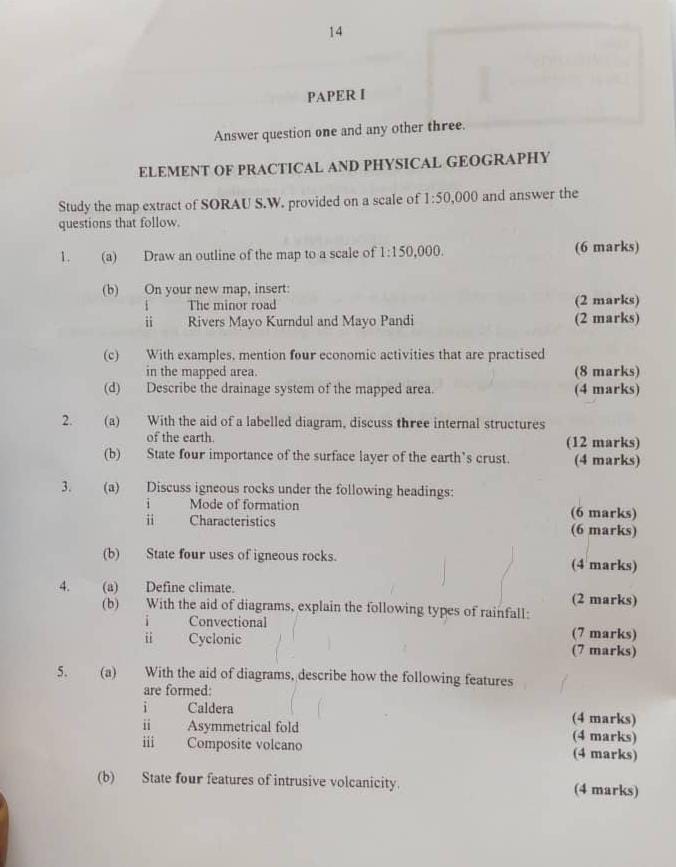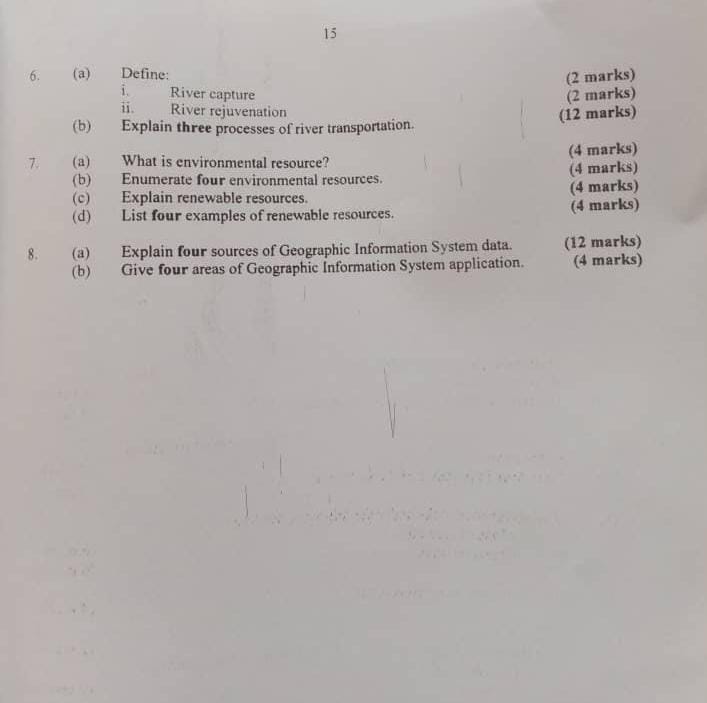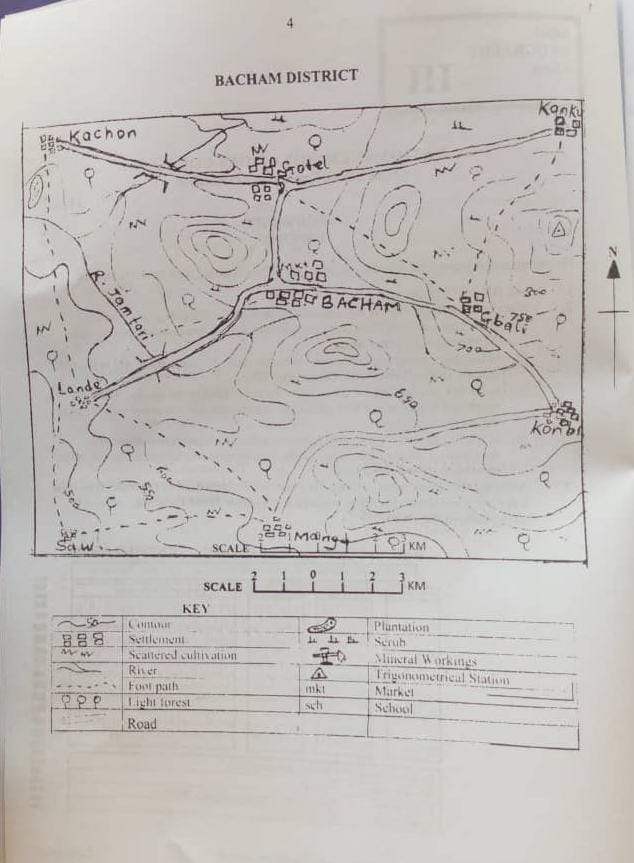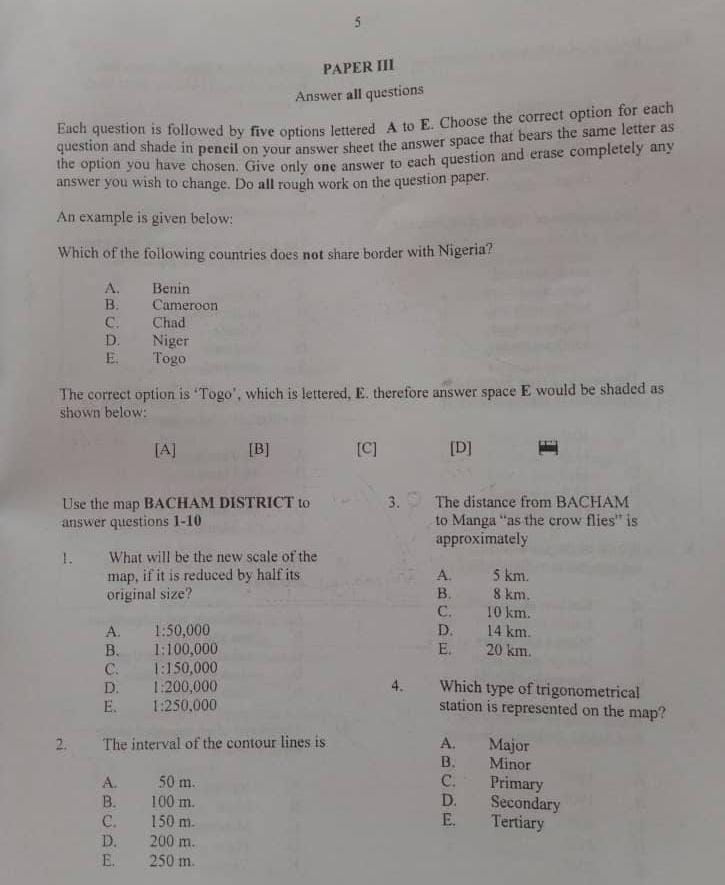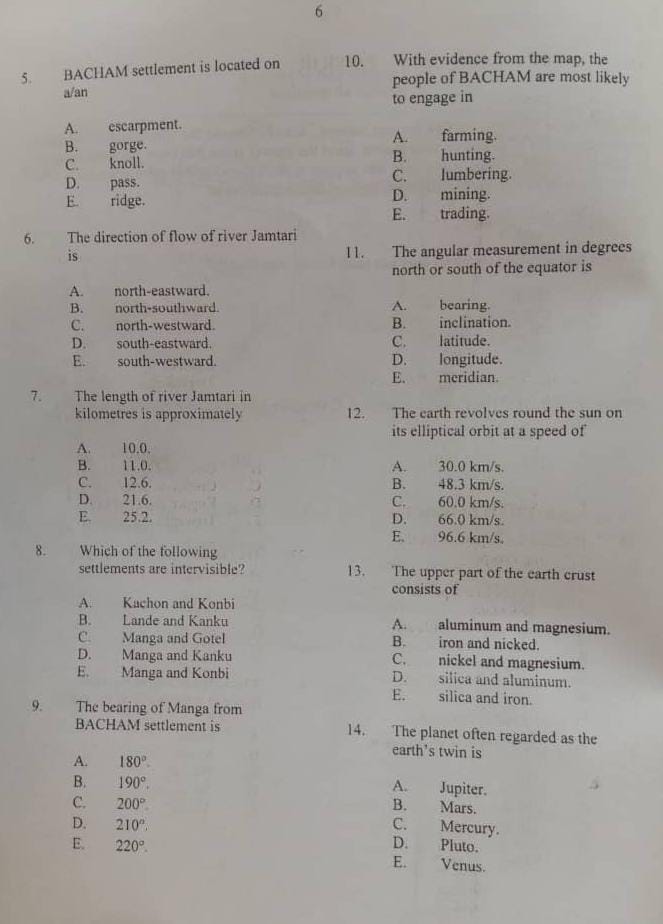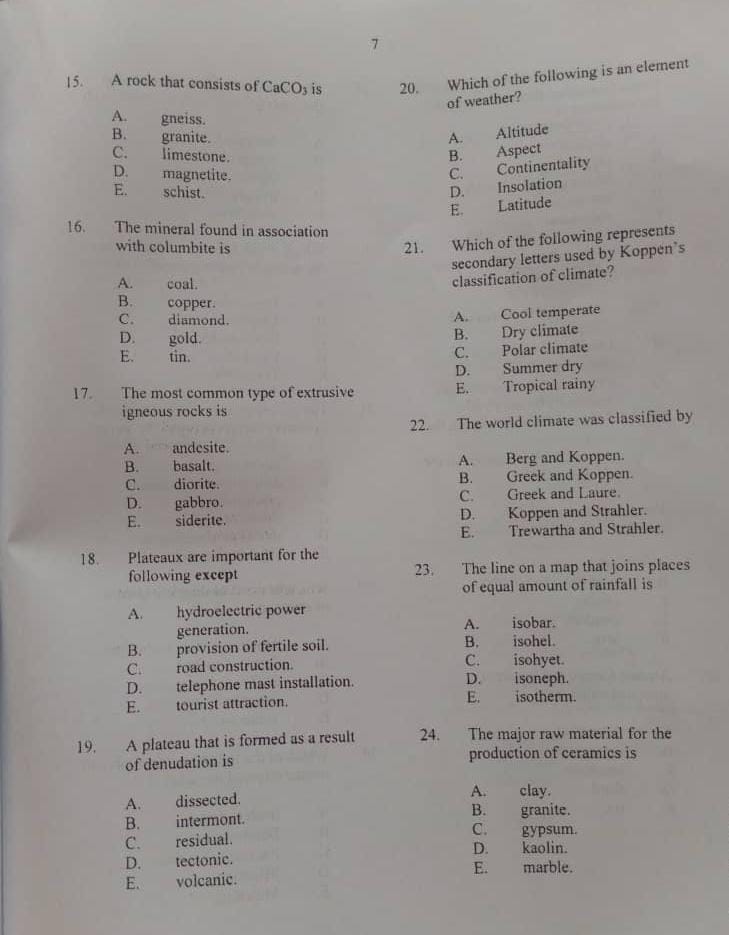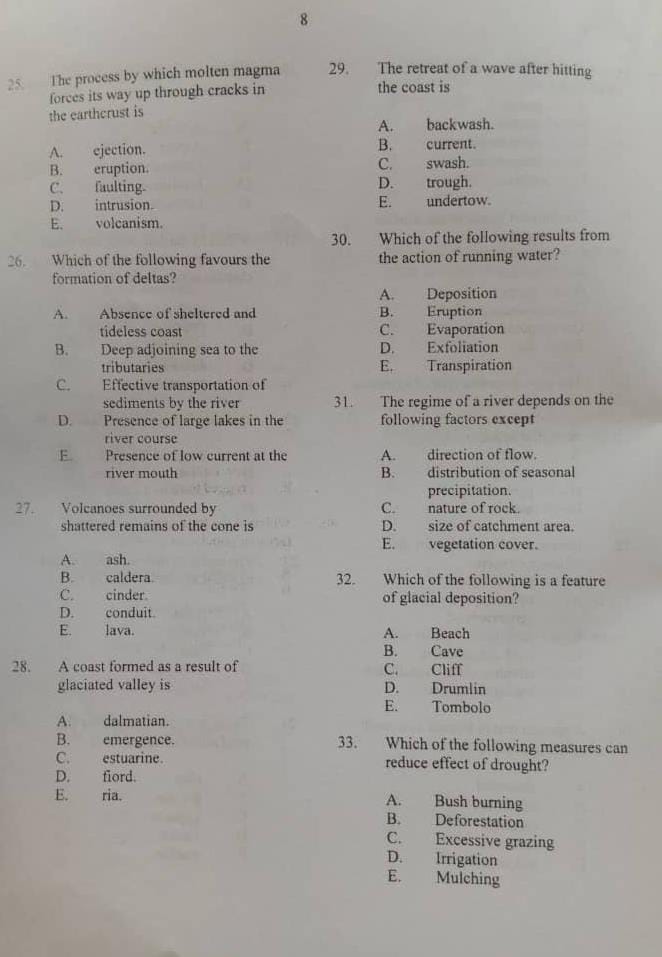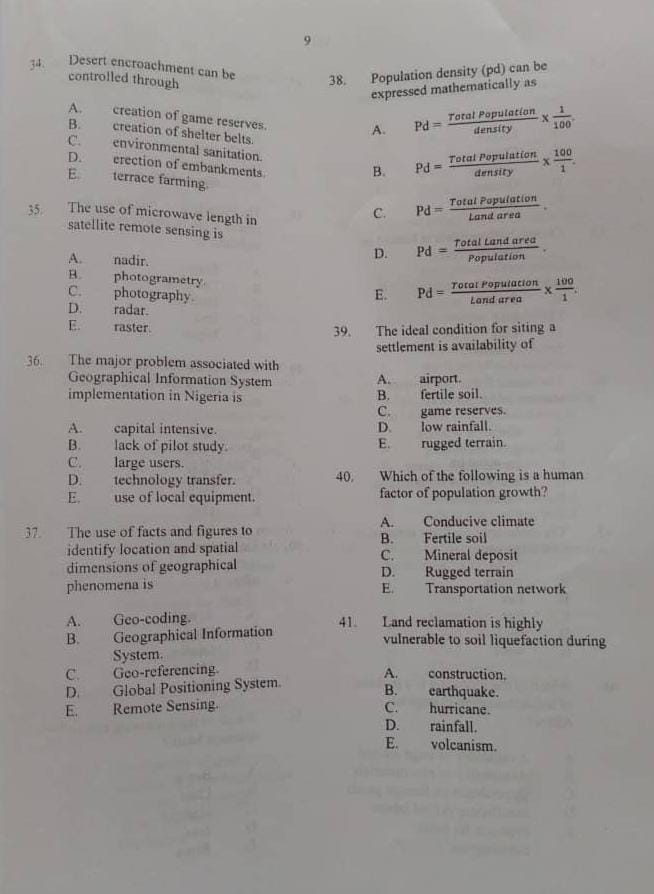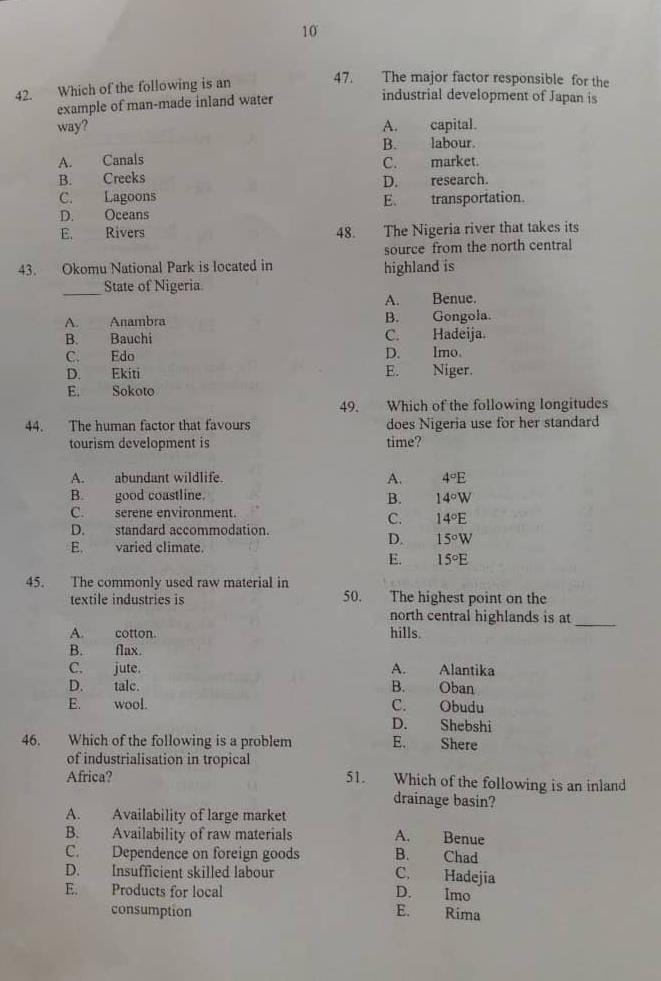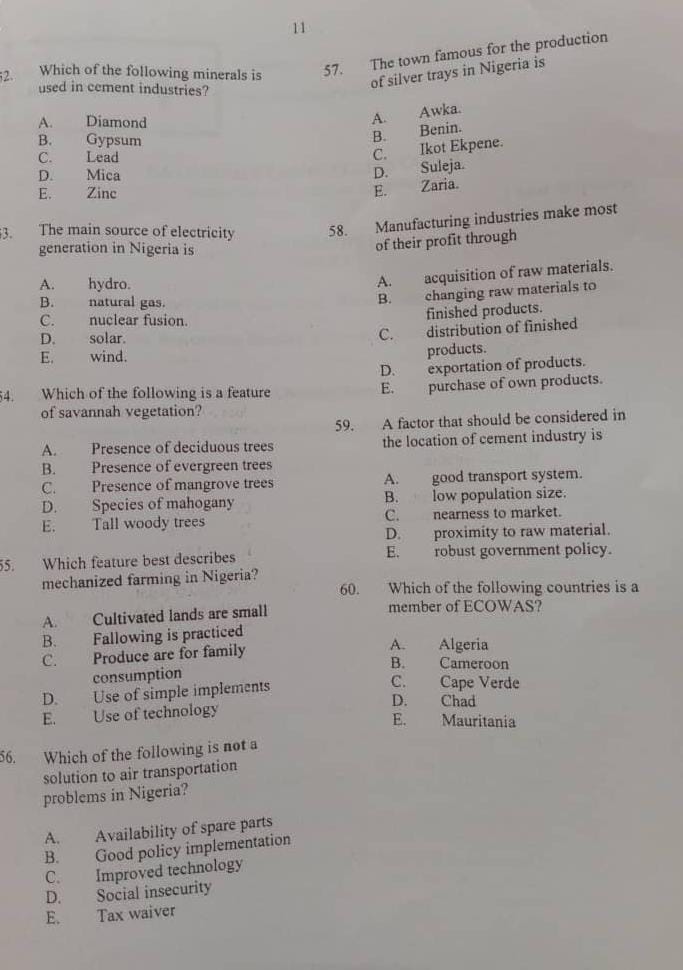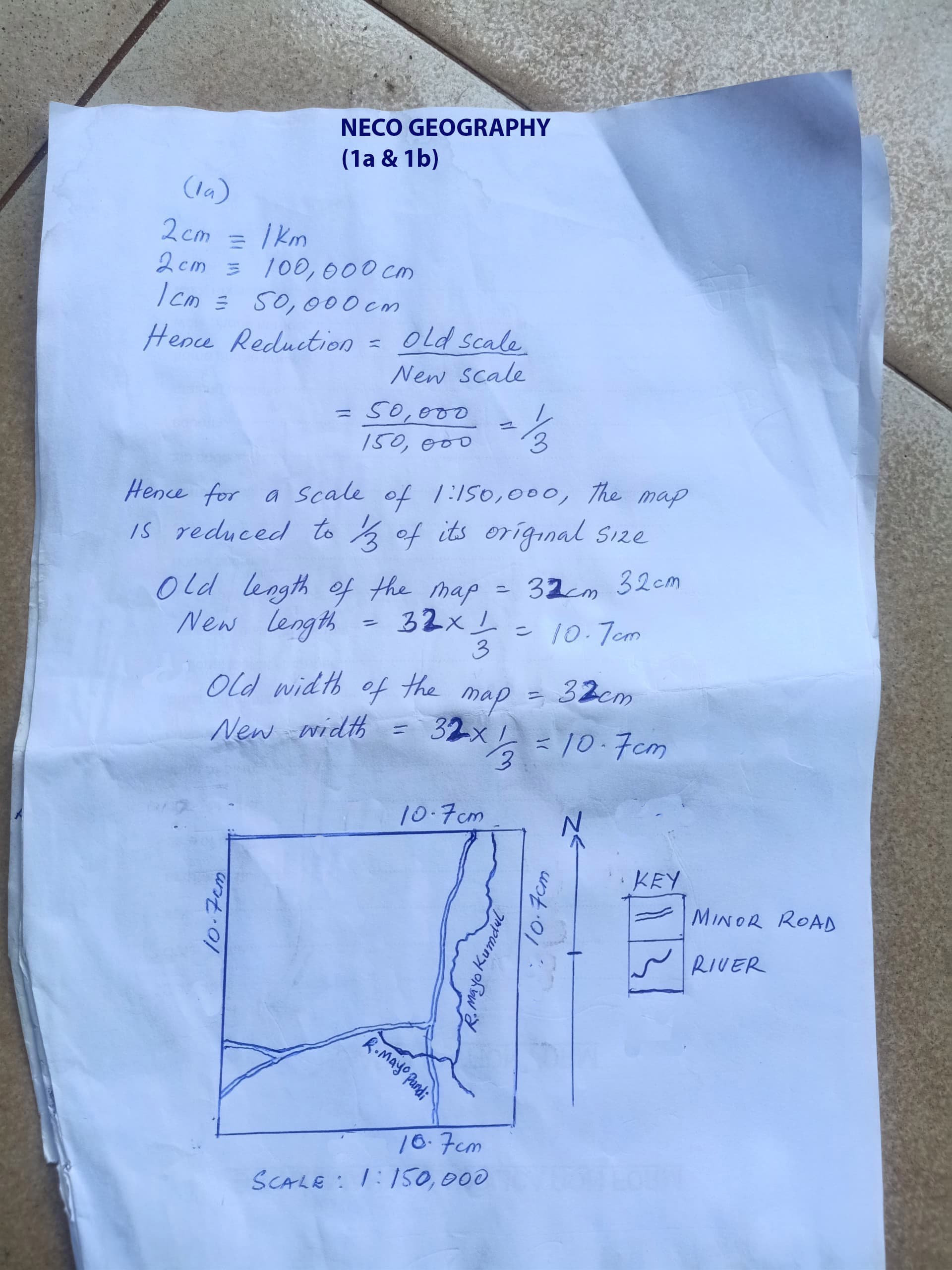Join Our Telegram Channel
Join Our Whatsapp Group
Friday, 28th June 2024
Geography (Objective & Practical/ Physical)
10:00am - 12:30pm
GEOGRAPHY OBJ:
1-10: DABCECCEAE
11-20: CADECEBBCD
21-30: DDCADCBDAA
31-40: ADDBDACCBE
41-50: BAADADDACD
51-60: BBAAEDEBDC
(WITH NUMBERING)
1.D 2.A 3.B 4.C 5.E 6.C 7.C 8.E 9.A 10.E
11.C 12.A 13.D 14.E 15.C 16.E 17.B 18.B 19.C 20.D
21.D 22.D 23.C 24.A 25.D 26.C 27.B 28.D 29.A 30.A
31.A 32.D 33.D 34.B 35.D 36.A 37.C 38.C 39.B 40.E
41.B 42.A 43.A 44.D 45.A 46.D 47.D 48.A 49.C 50.D
51.B 52.B 53.A 54.A 55.E 56.D 57.E 58.B 59.D 60.C
POSTED: 3, 4, 5, 6
No.1 and OBJ COMING SHORTLY
(1)
????(1c)
(PICK ANY FOUR)
(i) Tourism due to presence of antiquity in the map
(i) Fishing due to presence of rivers
(iii) Transportation due to presence of road
(iv) Trading due to presence of market in the map
(v) Lumbering due to presence of forest
(1d)
It is a dendritic drainage pattern. The main river and its tributaries develop certain patterns from their basin. The subsequent rivers joined the main river called the consequence river at oblique angle. It is a tree-like structure ie like branches of tree.
(3ai)
Mode of Formation:
Igneous rocks are formed as a result of hot molten magma escaping to earth surface and cooling. On reaching the surface, the rocks cool to form glassy o.r coarsely crystalline textured mass. Some of the magma may cool before reaching the earth surface thus forming plutonic rocks while some may reach the surface to form volcanic rocks. Rapid cooling gives rise to fine grained rocks, while slow cooling gives raise to larger grained rocks.
(3aii)
Characteristics:
Igneous rocks typically exhibit the following characteristics
(i) Their texture depends on the rate of cooling; slow cooling results in coarse-grained rocks (like granite), while fast cooling leads to fine-grained rocks (like basalt).
(ii) It is composed of minerals such as quartz, feldspar, mica, and pyroxene.
(iii) It varies in color, depending on mineral content; can range from light to dark, often reflecting their silica content.
(iv) It is generally hard and dense due to their mineral composition and cooling history.
(v) It can be formed beneath the earth as intrusive rocks. Examples are gabbro, granite, etc or on surface of the earth as extrusive rocks
(3b)
(PICK ANY FOUR)
(i) It used as building materials for monuments, countertops, and structural components due to their durability and aesthetic appeal.
(ii) Crushed igneous rocks like basalt and granite are used as aggregates in road construction.
(iii) Certain igneous rocks, such as obsidian and granite, are used as gemstones and ornamental stones.
(iv) It is used in the manufacturing of ceramics, porcelain, and glass due to their heat resistance and stability.
(v) It can be used for decorative purposes in landscaping and gardening, often as crushed stone or decorative boulders.
(vi) It is utilized in industries for abrasive materials, grinding stones, and as a source of mineral ores.
(4a)
Climate refers to the long-term average of weather conditions in a specific region, including aspects such as temperature, precipitation, humidity, wind patterns, and other atmospheric phenomena.
(4bi)
CONVECTIONAL RAINFALL:
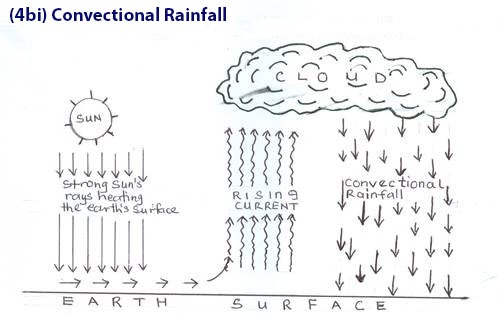
Convectional rainfall occurs due to the heating of the Earth’s surface, which leads to the rising of warm air. As the warm air rises, it cools and condenses, forming clouds. If these clouds continue to develop, they can produce precipitation in the form of rain.Convectional rainfall is common in tropical regions where intense heating during the day causes rapid vertical uplift of air.
(4bii)
CYCLONIC RAINFALL:
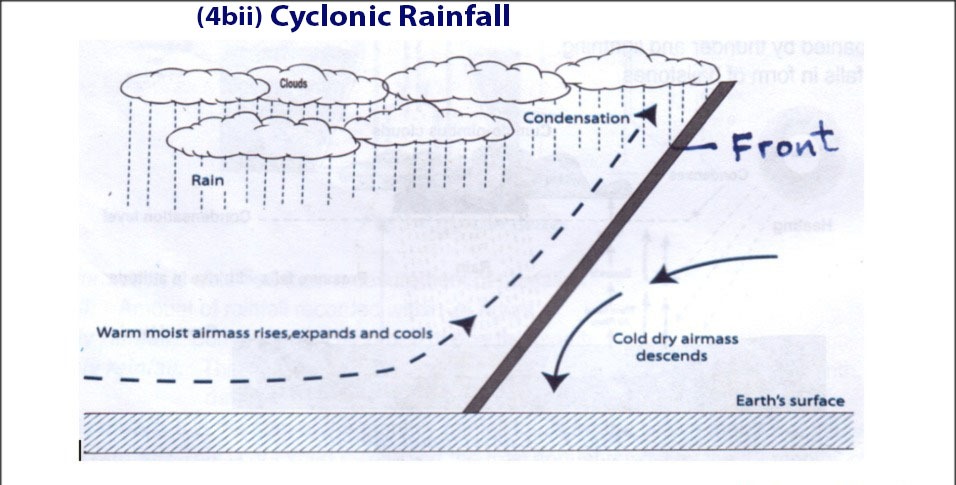
Cyclonic rainfall occurs when warm air masses and cold air masses meet along a weather front. As the warm, moist air is forced to rise over the denser, cooler air, it cools, condenses, and forms clouds.This process typically occurs over a larger area and is associated with cyclones or frontal systems.
(5ai)
Caldera:
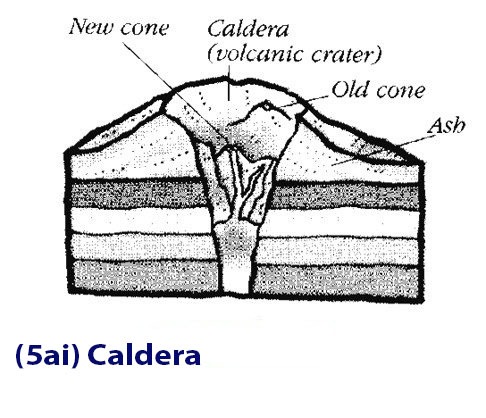
A caldera is a large volcanic crater formed by the collapse of a volcanic cone or by explosive volcanic activity. It typically forms after a massive eruption where the magma chamber underneath a volcano is emptied, causing the overlying rock to collapse into the empty space.
(5aii)
Asymmetrical fold:
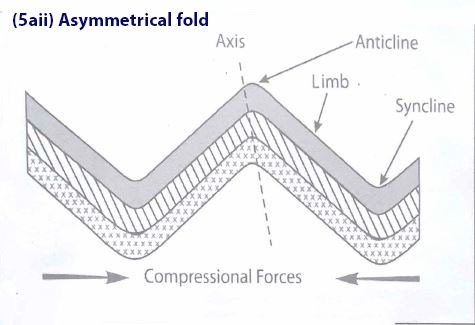
An asymmetrical fold is a type of geological fold where one limb (side) of the fold is steeper than the other. It forms due to compressional forces in the Earth’s crust, causing layers of rock to bend and fold asymmetrically.
(5aiii)
Composite volcano:

A composite volcano forms from alternating layers of lava flows, ash, and volcanic rocks. These volcanoes are typically steep-sided and have a symmetrical cone shape due to their alternating eruptions of viscous lava and explosive eruptions
(5b)
(PICK ANY FOUR)
(i) Batholiths: Large, irregular-shaped intrusive rock masses formed from cooled magma deep within the Earth’s crust.
(ii) Sills have Horizontal sheets of igneous rock that intrude parallel to the layering of pre-existing rock formations.
(iii) Dikes: Vertical or near-vertical sheets of igneous rock that cut across the layering of pre-existing rock formations.
(iv) Laccoliths: Intrusions that form when magma is injected between layers of sedimentary rock, causing the overlying layers to bulge upward.
(v) Stocks: Smaller, irregular intrusive bodies that are similar to batholiths but smaller in size.
(vi) Plugs or volcanic necks: Formed when magma hardens within the vent of a volcano after volcanic activity has ceased, leaving behind a solidified plug of lava.
(vii) Lopoliths: Intrusions that have a concave-up shape due to the magma being injected beneath a flat-lying sedimentary rock layer.
(viii) Ring dikes: Circular or arcuate intrusions that surround a central pluton or volcanic vent
(6ai)
River capture:
River capture, also known as stream piracy, occurs when a river or stream is diverted from its own bed and flows instead into the bed of a neighboring river. This typically happens when the capturing river erodes through a divide between the two river systems.
(6aii) River rejuvenation:
River rejuvenation refers to the process by which a river gains renewed energy and begins to erode its bed more vigorously. This can be caused by a drop in the sea level, an uplift of land, or a reduction in sediment load, leading to the river cutting into its bed and forming features like terraces and incised meanders
(6b)
(PICK ANY THREE)
(i) Traction:
The process where large particles like boulders and rocks are rolled along the river bed by the force of the water. This typically occurs in the upper course of the river where the water’s velocity is high. The particles are too heavy to be lifted and are thus rolled or dragged along the bottom. This movement can lead to the rounding and smoothing of these particles over time.
(ii) Saltation:
The process where smaller, medium-sized particles like pebbles and gravel are bounced along the river bed. These particles are lifted off the bed by the force of the water and then fall back to the river bed in a leapfrog motion. This process requires a moderately fast flow and is common in both the upper and middle courses of the river.
(iii) Suspension:
The process by which fine particles like silt and clay are carried within the water column.
These particles are small and light enough to be carried along by the turbulent flow of the water. Suspension gives rivers a muddy appearance and is a dominant transportation process in the middle and lower courses of the river, where the water flow is slower but still turbulent enough to keep these fine particles in motion.
(iv) Solution:
The process where soluble materials are dissolved in the water and carried along in solution. This includes minerals like calcium carbonate and salts that are dissolved from the bedrock and soil. These materials are invisible in the water but are an important part of the river’s load. This process occurs throughout the river’s course and is especially significant in areas with limestone or chalk geology.
Answers Loading...
QUESTIONS:

